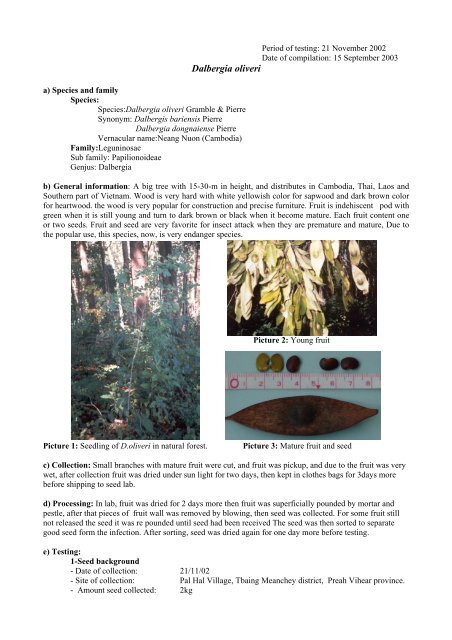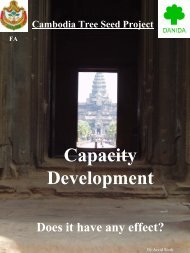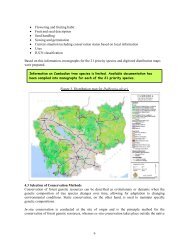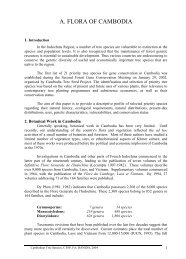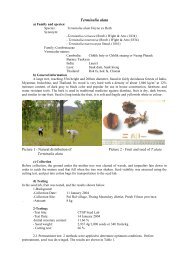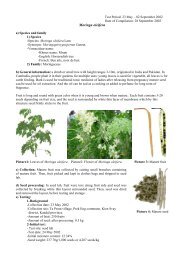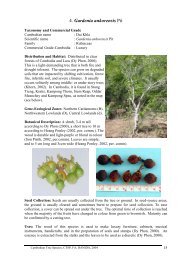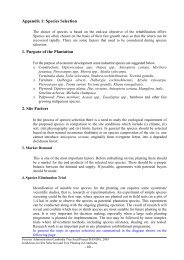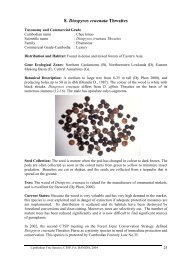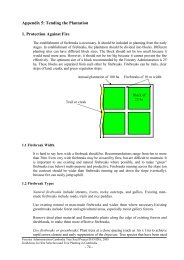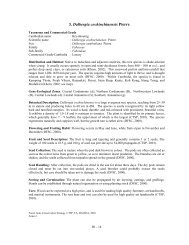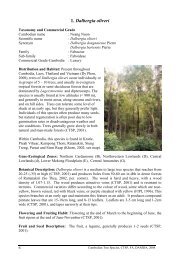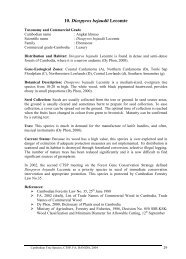Dalbergia oliveri - Cambodia Tree Seed Project
Dalbergia oliveri - Cambodia Tree Seed Project
Dalbergia oliveri - Cambodia Tree Seed Project
You also want an ePaper? Increase the reach of your titles
YUMPU automatically turns print PDFs into web optimized ePapers that Google loves.
a) Species and family<br />
Species:<br />
Species:<strong>Dalbergia</strong> <strong>oliveri</strong> Gramble & Pierre<br />
Synonym: Dalbergis bariensis Pierre<br />
<strong>Dalbergia</strong> dongnaiense Pierre<br />
Vernacular name:Neang Nuon (<strong>Cambodia</strong>)<br />
Family:Leguninosae<br />
Sub family: Papilionoideae<br />
Genjus: <strong>Dalbergia</strong><br />
Period of testing: 21 November 2002<br />
Date of compilation: 15 September 2003<br />
<strong>Dalbergia</strong> <strong>oliveri</strong><br />
b) General information: A big tree with 15-30-m in height, and distributes in <strong>Cambodia</strong>, Thai, Laos and<br />
Southern part of Vietnam. Wood is very hard with white yellowish color for sapwood and dark brown color<br />
for heartwood. the wood is very popular for construction and precise furniture. Fruit is indehiscent pod with<br />
green when it is still young and turn to dark brown or black when it become mature. Each fruit content one<br />
or two seeds. Fruit and seed are very favorite for insect attack when they are premature and mature, Due to<br />
the popular use, this species, now, is very endanger species.<br />
Picture 2: Young fruit<br />
Picture 1: <strong>Seed</strong>ling of D.<strong>oliveri</strong> in natural forest.<br />
Picture 3: Mature fruit and seed<br />
c) Collection: Small branches with mature fruit were cut, and fruit was pickup, and due to the fruit was very<br />
wet, after collection fruit was dried under sun light for two days, then kept in clothes bags for 3days more<br />
before shipping to seed lab.<br />
d) Processing: In lab, fruit was dried for 2 days more then fruit was superficially pounded by mortar and<br />
pestle, after that pieces of fruit wall was removed by blowing, then seed was collected. For some fruit still<br />
not released the seed it was re pounded until seed had been received The seed was then sorted to separate<br />
good seed form the infection. After sorting, seed was dried again for one day more before testing.<br />
e) Testing:<br />
1-<strong>Seed</strong> background<br />
- Date of collection: 21/11/02<br />
- Site of collection: Pal Hal Village, Tbaing Meanchey district, Preah Vihear province.<br />
- Amount seed collected: 2kg
2-Initial test<br />
- Site for testing: CTSP <strong>Seed</strong> Lab<br />
-Test Date: 04 December 2002<br />
-Initial moisture content: 14.29 %<br />
-<strong>Seed</strong> weight:<br />
163g /1,000 seeds or 6135 seeds/kg<br />
-Cutting test: 89 %<br />
3- Pretreatment test:<br />
Four different temperatures of water and burn seed with seed burner were applied for pre treatment test, and<br />
result shown below:<br />
Table 1: Result of pre treatment test.<br />
Pretreatment Germination for 1week % Germination rate (%)<br />
A- No pretreatment ( control) 11 55<br />
B-Soak in normal water over night 11 50<br />
C- Soak in 40°C water and left to cool over night 16 64<br />
D-Burn fruit wall, then soak in normal water over<br />
night<br />
4 10<br />
Conclusion: The 3 method with temperature of water ranges from normal to 40°C provides a more satisfied<br />
result compare to burning seed with seed burner. So, seed D.<strong>oliveri</strong> does not content dormancy, because<br />
appropriate temperature of water is not quite hot (40 °C) and could be considered as normal water.<br />
4- Storage trial<br />
<strong>Seed</strong> was divided to two groups and stored in two different condition: ambient room, and room with<br />
temperature is about 10°C . The result received from this storage displayed below: C.<br />
Table 2 –Result of storage trial<br />
Period of storage Condition of storage Moisture content (%) Germination rate (%)<br />
1 month<br />
10°C 14.17 65<br />
Ambient 14.99 60<br />
3 months<br />
10 earlier 13.59 61<br />
Ambient 13.58 36<br />
6 months<br />
10°C 13.47 50<br />
Ambient 13.20 7<br />
9 months<br />
10°C 13.36 56<br />
Ambient 13.21 0<br />
12 months<br />
10°C 13.23 33<br />
Ambient 12.81 0<br />
Conclusion: Storage in a refrigerator can extend the viability of seed better then in ambient room. In an<br />
ordinary room the best results showed a storage period of one month only.<br />
f) Comments for seed procurement: Fruit of D.<strong>oliveri</strong> should be collected in December -January, if left<br />
any later, the fruit may be damaged by insects. After collecting, fruit should be dried under sunlight to ease<br />
seed extraction. After drying, fruit should be superficially pounded by mortar and pestle, leaf waste removed,<br />
and the unprocessed fruit re-pounded. <strong>Seed</strong> attacked by insects needs to be removed, and if the attack was<br />
serious, all seed should be floated in water, and only the sunken seed kept and dried again before storage. If<br />
possible, insecticide should be applied to the seed before storage, but care must be taken to ensure that this<br />
does not harm the seed.<br />
<strong>Seed</strong> should be sown as soon as possible into nursery beds. However, if it has to be stored, it should be in a<br />
refrigerator at a temperature of 10°C. If this facility is unavailable, the seed can be kept in closed plastic bag<br />
and placed in an ordinary room or shaded place in a temperature not exceeding 30°C. In the latter case, the<br />
duration of storage is limited to less than 3 months.


